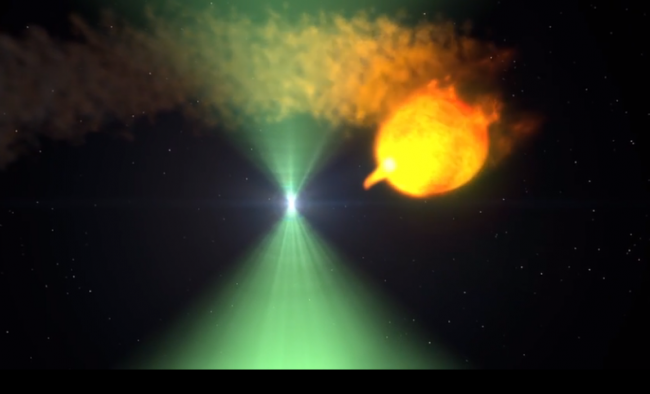This artist's rendering shows one model of pulsar J1023 before its radio emission (green) vanished. Normally, an outflow of high-energy particles from the pulsar staves off the gas stream from its companion. NASA's Goddard Space Flight Center
An exceptional binary containing a rapidly spinning neutron star underwent a dramatic change in behavior never before observed — the pulsar’s radio beacon vanished while at the same time the system brightened fivefold in gamma rays.
By NASA’s Goddard Space Flight Center, Greenbelt, Maryland | Published: Wednesday, July 23, 2014
In late June 2013, an exceptional binary containing a rapidly spinning neutron star underwent a dramatic change in behavior never before observed. The pulsar’s radio beacon vanished while at the same time the system brightened fivefold in gamma rays, the most powerful form of light, according to measurements by NASA’s Fermi Gamma-ray Space Telescope.
“It’s almost as if someone flipped a switch, morphing the system from a lower-energy state to a higher-energy one,” said Benjamin Stappers from the University of Manchester in England, who led an international effort to understand this striking transformation. “The change appears to reflect an erratic interaction between the pulsar and its companion, one that allows us an opportunity to explore a rare transitional phase in the life of this binary.”
A binary consists of two stars orbiting around their common center of mass. This system, known as AY Sextantis, is located about 4,400 light-years away in the constellation Sextans. It pairs a 1.7-millisecond pulsar named PSR J1023+0038 (J1023) with a star containing about one-fifth the mass of the Sun. The stars complete an orbit in only 4.8 hours, which places them so close together that the pulsar will gradually evaporate its companion.
When a massive star collapses and explodes as a supernova, its crushed core may survive as a compact remnant called a neutron star or pulsar, an object squeezing more mass than the Sun’s into a sphere no larger than Washington, D.C. Young isolated neutron stars rotate tens of times each second and generate beams of radio, visible light, X-rays, and gamma rays that astronomers observe as pulses whenever the beams sweep past Earth. Pulsars also generate powerful outflows, or “winds,” of high-energy particles moving near the speed of light. The power for all this comes from the pulsar’s rapidly spinning magnetic field, and over time, as the pulsars wind down, these emissions fade.
More than 30 years ago, astronomers discovered another type of pulsar revolving in 10 milliseconds or less, reaching rotational speeds up to 43,000 rpm. While young pulsars usually appear in isolation, more than half of millisecond pulsars occur in binary systems, which suggested an explanation for their rapid spin.
“Astronomers have long suspected millisecond pulsars were spun up through the transfer and accumulation of matter from their companion stars, so we often refer to them as recycled pulsars,” said Anne Archibald from the Netherlands Institute for Radio Astronomy (ASTRON) in Dwingeloo, who discovered J1023 in 2007.
During the initial mass-transfer stage, the system would qualify as a low-mass X-ray binary, with a slower-spinning neutron star emitting X-ray pulses as hot gas raced toward its surface. A billion years later, when the flow of matter comes to a halt, the system would be classified as a spun-up millisecond pulsar with radio emissions powered by a rapidly rotating magnetic field.
To better understand J1023’s spin and orbital evolution, astronomers regularly monitored the system in radio using the Lovell Telescope in the United Kingdom and the Westerbork Synthesis Radio Telescope in the Netherlands. These observations revealed that the pulsar’s radio signal had turned off and prompted the search for an associated change in its gamma-ray properties.
Read the full Astronomy magazine online article here…
To view the You Tube video explaining the transformer Pulsar mechanism click here

